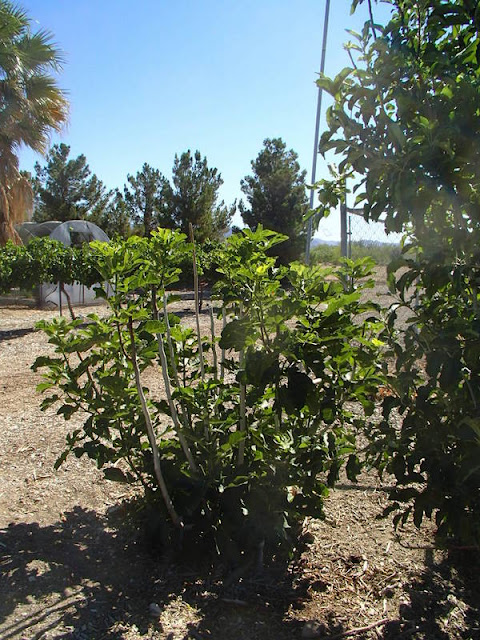Q. I am interested in planting a fruit tree in my yard.
After reading your blog, I was thinking of a fig tree, however I have been told
that they can get very large. I wanted to stay under 8 feet tall and not
difficult to grow. When should I plant it and where?
After reading your blog, I was thinking of a fig tree, however I have been told
that they can get very large. I wanted to stay under 8 feet tall and not
difficult to grow. When should I plant it and where?
 |
| Fig trees like this one can be cut very short when they are older and they will still sucker and sprout, regrowing again. |
A. Fig trees will grow very large but they can be
severely cut back near the ground, if needed, and they will grow again. But I
don’t think you want that kind of work and maintenance. There are some smaller
fig trees like Black Jack fig but generally figs are large trees.
severely cut back near the ground, if needed, and they will grow again. But I
don’t think you want that kind of work and maintenance. There are some smaller
fig trees like Black Jack fig but generally figs are large trees.
Fruit
trees that fit your description are called miniatures or genetic dwarf fruit
trees. They stay very small but produce a lot of fruit of normal size. In my
opinion, fruit produced by miniature fruit trees do not taste not as good as some
fruit from regular fruit trees but pretty good for the casual backyard
producer.
trees that fit your description are called miniatures or genetic dwarf fruit
trees. They stay very small but produce a lot of fruit of normal size. In my
opinion, fruit produced by miniature fruit trees do not taste not as good as some
fruit from regular fruit trees but pretty good for the casual backyard
producer.
The
problem is terminology; the terms used to describe these types of fruit trees.
The terms thrown around in nurseries casually are “dwarf”, “semi dwarf”,
“miniature” and “genetic dwarf”. I just looked online and these terms are
confused in most, if not all the online fruit tree nurseries. I’m assuming
they’re confused in local nurseries as well.
problem is terminology; the terms used to describe these types of fruit trees.
The terms thrown around in nurseries casually are “dwarf”, “semi dwarf”,
“miniature” and “genetic dwarf”. I just looked online and these terms are
confused in most, if not all the online fruit tree nurseries. I’m assuming
they’re confused in local nurseries as well.
A dwarf
or semi dwarf fruit tree can be created by grafting a dwarfing rootstock onto a
normal fruit tree. This could be called a “dwarf” or “semi dwarf” fruit tree.
They will not meet your eight-foot tall criterion in most cases. The possible
exception could be apple trees.
or semi dwarf fruit tree can be created by grafting a dwarfing rootstock onto a
normal fruit tree. This could be called a “dwarf” or “semi dwarf” fruit tree.
They will not meet your eight-foot tall criterion in most cases. The possible
exception could be apple trees.
Miniatures
are sometimes the same as semi dwarf. Miniatures are sometimes genetic dwarfs.
It depends on the nursery and their definitions of these terms. Sometimes
nurseries create these names for marketing purposes and, in my opinion, cause a
great deal of confusion.
are sometimes the same as semi dwarf. Miniatures are sometimes genetic dwarfs.
It depends on the nursery and their definitions of these terms. Sometimes
nurseries create these names for marketing purposes and, in my opinion, cause a
great deal of confusion.
 |
| When considering fruit trees for containers you might want to look closely at genetic dwarf fruit trees as a possibility. |
In most
cases you are looking for what is called a “genetic dwarf”. But like I said,
sometimes these are called miniatures. The only real way to know is to find out
their true mature size. Nurseries think that small size can be a big selling
advantage.
cases you are looking for what is called a “genetic dwarf”. But like I said,
sometimes these are called miniatures. The only real way to know is to find out
their true mature size. Nurseries think that small size can be a big selling
advantage.
If the
term “dwarf”, “semi dwarf”, “miniature” or “genetic dwarf” is used in its
description, check its mature size. It may not be exactly what you think it is.
If the mature size is not listed, don’t get sucked in by the marketing. Assume
it is larger than you think.
term “dwarf”, “semi dwarf”, “miniature” or “genetic dwarf” is used in its
description, check its mature size. It may not be exactly what you think it is.
If the mature size is not listed, don’t get sucked in by the marketing. Assume
it is larger than you think.
The very
small sized fruit trees that I refer to as miniature or genetic dwarf can be
found in almond, peach, nectarine, and apple and vary in height from 6 to 12
feet tall.
small sized fruit trees that I refer to as miniature or genetic dwarf can be
found in almond, peach, nectarine, and apple and vary in height from 6 to 12
feet tall.


